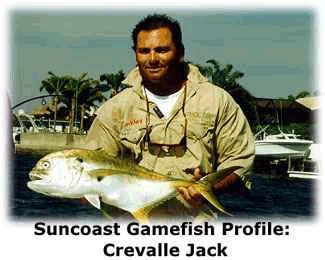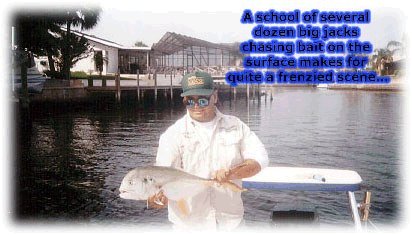Pound for pound inch for inch tooth for tooth the toughest, fightin'est, downright meanest Suncoast inshore gamefish is the crevalle jack, or as he is more simply known jack. This ball of fire brings the total package - vicious strikes, searing, drag-scorching runs and a head-shaking, doggedly determined fighting style that continues even after he's in the boat (watch those fingers)!. Jacks are pretty easy to find - they roam in packs, hunting baitfish of all type. They herd their quarry into a given area, then launch the attack, snapping their formidable teeth at anything that moves. The panicked baitfish often head for the surface, closely followed by the jacks - creating a mass of frothing water that's a dead giveaway to their presence. Jacks will often corner their intended meal against a seawall or other structure, cutting off the baitfishs' escape route. A school of several dozen big jacks chasing bait on the surface makes for quite a frenzied scene - and an almost-guaranteed hook-up for the angler close enough to lob a bait into the melee. Jacks are around the Suncoast waters all year - in fact, they're a reliable standby during the dead of winter spells that we occasionally have. Many a frustrated February flyrodder has had his day saved by a few big jacks chomping a streamer fly. If you're drift fishing the flats, drop a chum block in the water and wait - it probably won't be long before the jacks show up, wondering what smells so good and looking for a free meal. We generally categorize jacks as inshore fish, but the fact is they're also found well offshore, generally around wrecks and reefs but also in open water. They usually run in the 2-10 pound range, but they grow to over 50 pounds - a jack in the 25-30 pound range is a double handful on any type of inshore tackle. Most jacks are caught "accidentally" - that is, they are not the targeted species of most anglers. The reason why these fierce battlers are not highly sought after is that they're not very good to eat. The flesh of a jack is very bloody and dark, and the meat simply tastes too strong for most folks' palate. If you know of a good recipe for jacks, we'd love to know it just please don't send the old "throw the fish away and eat the board" joke. Tackle requirements everything from flyrods to heavy offshore tackle has been used to land a jack. Spinning tackle in the 6 - 12 pound range allows the fish to give a good account of itself, and will definitely present you with a challenge if a whopper grabs hold. For pure flat-out angling fun, though, it's tough to imagine anything better than a 9 wt. flyrod and a school of hungry 8-10 pound crevalle jacks. You'll become well-acquainted with a fair portion of your backing and get good insight into the condition of your drag (not to mention your wrist and forearm). You'll also sharpen your playing and landing skills in preparation for the day when it's a 20 pound snook holding onto your Clouser Minnow. Best baits name it. Hungry jacks will take a swipe at just about anything, and can become a nuisance when they start grabbing those sardines you worked so hard to find. If you see a school you want to tangle with, toss a flashy jig or spoon into the midst of the fracas and hold on tight. It's a good idea to use 20-30 pound leader, maybe even wire if you know the jacks are running really big. Flyrodders should attach a 20 pound shock tippet to guard against those fearsome choppers. That's it for the jack. They are tons of fun, and provide reliable action on the days when everything else develops lockjaw. Show them the respect they deserve - practice catch and release, use bronze hooks and cut the line if the fish swallows the bait. |
Florida Saltwater Fishing in the Gulf of Mexico





